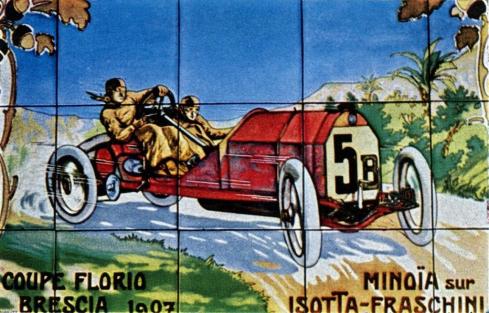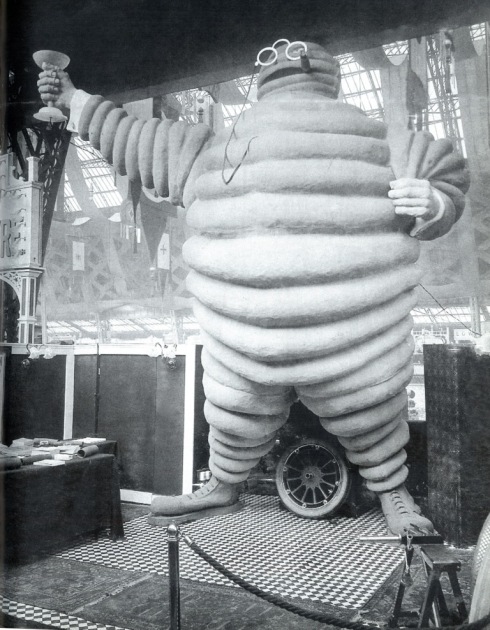People who know the way my mind works will already have been expecting this post after I reminded myself about the Michelin Man’s connection with Chelsea the other week and been wondering why we haven’t been here before. Those who know me spookily well will also make the connection with one of my literary heroes William Gibson, who included the image of the man made of tyres in his novel Pattern Recognition (which doesn’t have quite enough scenes set in the Borough to qualify for my fiction in K&C series). The protagonist Cayce Pollard finds some brands and trademarks toxic and disruptive to her talents. An enemy of hers uses the image of the Michelin Man against her. “that weird, jaded, cigar-smoking elder creature suggesting a mummy with elephantiasis. ” She counters the effect in various ways including a mantra: he took a duck in the face at two hundred and fifty knots. Fortunately she never goes near 81 Fulham Road. (Any other sufferers from semiotic distress should avert their eyes for the next few pictures)
The Michelin Man himself goes back to the 1890s when Edouard Michelin was struck by the anthropomorphic possibilities of a pile of tyres at a trades exhibition and asked the uniquely named graphic artist O’Galop to bring the conception to life. The new mascot got his name from a Latin phrase from the poet Horace: Nunc est bibendum (now is the time to drink) which in this case referred to the unstoppable nature of the pneumatic tyres, drinking up obstacles . (“le pneu Michelin boit l’obstacle!”) Bibendum was depicted holding up a glass full of nails and other debris of the highway. (The other hand of course held a cigar, indicating a love of the good life). He starred in a variety of posters from 1898 onwards.
Bibendum rapidly became not just a symbol of the Michelin company but a cultural icon in his own right, popping up in all sorts of places.
He had become one of the new icons of industry and advertising. Andre Michelin entered motor races to demonstrate the superiority of the tyres. The Michelin company published its first guide book, promoting the idea of road travel, tourism and the rating of restaurants – the start of a parallel industry for them.
In the UK the company decided it needed a headquarters which would combine administrative, retail and promotional functions. The Michelin building was born in what was then a relatively obscure, largely commercial, area where Chelsea met Kensington.
Michelin House, designed by Francois Espinasse and opened in 1911 turned out to be an imaginative, stylish and unique addition to the Chelsea landscape, and a celebration of their emblem. Bibendum had long since attained corporeal form and appeared in public for trade fairs, publicity events and even carnivals, as we saw a couple of weeks ago. He had become very much like a figure from folklore or a minor deity. Below he pays a visit to his new Art Nouveau temple in its opening year.
Note the stained glass windows, suitable for a 20th century cathedral, and the two spherical structures on either end of the facade. Originally two giant effigies of Bibendum were intended to stand there.
Inside there was a grand reception area.
A “touring office” like a reference library where travelers could plan their road trips.
And a workshop. Tyres could be bought, fitted, checked and repaired on the premises.
The exterior of the building also celebrated the company’s sporting achievements.
A series of 34 ceramic panels depicted the exciting days of early motor sport.
The building added prestige to the Michelin brand and its ubiquitous emblem.
But times change, even for the demi-gods of advertising iconography. Michelin moved its head office in the 1930s, the stained glass windows were removed for fear of possible bomb damage (and subsequently lost) in 1940. The two globes had also gone by the time of this photo from 1971.
This gloomy undated picture from our planning department shows that alterations were planned.
But in 1985 the whole building was bought by Sir Terence Conran and Paul Hamlyn. The picture below also came from our planning collection. The globes were restored and the windows recreated as the building entered a new phase of its history.
The new version of the interior featured restaurants.
And retail – below, an 80s woman choosing candles.
In 1988 the Illustrated London News featured the building as the first in a series they called sacred cows. As I went down to the Reference Store to find the article featuring these three images (“Palace of Vanities”) I noted that the bound volumes of the illustrious ILN came to an end a few years later. The great magazine unfortunately ceased publication in 1994.
Bibendum’s house survives, and still amazes the passer by.
Finally, back to where we began, with the early history of the man of tyres. Anyone sensitive to advertising, or just sensitive, should look away now….
Postscript
The Michelin building is more of a hidden treasure than a sacred cow. As someone who lives in Chelsea I have to admit that I seldom see it. I just don’t go that way very often. But whenever I do it cheers me up. London should have more buildings like it.
The Library has a virtually complete set of the Illustrated London News from 1842 to 1994. It remains an amazing historical source. A digital version of the ILN archives is also available.





















April 14th, 2016 at 9:15 am
Pneumatic bliss. Wonderful post, wonderful building.
April 16th, 2016 at 12:39 am
Fantastic! You heard my plea for a terrific post on the Michelin Building. I absolutely love walking by this building, and am so glad to learn more about its amazing history. Thank you!
May 7th, 2016 at 10:37 pm
I wonder is there another out there who has had a tyre repaired at 81 Fulham Road,eaten their full of oysters and lunched on numerous occasions at the large round table under the wonderful window on the first floor restaurant.
Reg Francis
June 1st, 2016 at 8:04 am
[…] Source: Monsieur Bibendum’s house: the Michelin Building | The Library Time Machine […]
July 23rd, 2016 at 3:20 pm
You wonder how long Sir Terence Conran had had his eyes on that building as he operated his first (?) habitat shop on the next door plot? He should be given a lot of credit for stepping in and saving the wonderful Michelin building. Those wonderful tiled plaques made a big impression on my childhood brain, so nice to see them again.
November 14th, 2016 at 11:55 am
i worked in the Michelin Tourism Dept for around 25 years and our head Office was based at this building until it was closed and moved to Harrow in the 80s. A little known fact is that the floor on the ground floor sloped towards the Sloane Avenue loading bay to ease the rolling of tyres towards the delivery vehicles. Its hard to believe now that this central London location was Michelins main tyre depot.
November 30th, 2020 at 12:17 pm
Hi, I’ve just read your post and I love it. It’s true, the Michelin house is too unique in its design and character and I agree that more buildings like this should exist. I also happen to be doing a research project on the Michelin House, and I am wondering where you found all of the amazing old pictures of the building. Would you be willing to share your source?
Thanks:)
December 4th, 2020 at 2:19 pm
Eli
The pictures came from our collection here at Local Studies
Dave
December 4th, 2020 at 5:55 pm
you mention a fiction series of books set in Kensington. how can i access it please. i have just read Muriel sparks a far cry from Kensington. the best diet book ever!
December 11th, 2020 at 1:34 am
Basia
That series never got off the ground but here’s what there is:
More Chelsea than Kensington I’m afraid, but there you go.
Dave